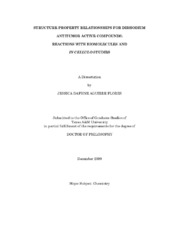| dc.description.abstract | The molecular characteristics that affect the activity of various
dirhodium complexes are reported. The importance of the axial position in
the action of dirhodium compounds was studied. Three dirhodium complexes
with increasing number of accessible axial coordination sites were
synthesized and characterized. In cis-[Rh2(u-OAc)2(np)2]2+ (np = 1,8-
naphthyridine) both axial sites are available for coordination, whereas for
cis-[Rh2(u-OAc)2(np)(pynp)]+2 (pynp = 2-(2-pyridyl)1,8-naphthyridine) and
cis-[Rh2(u-OAc)2(pynp)2]+2 the pyridyl arm on the ligand pynp blocks one and
two axial sites, respectively. The availability of the axial positions affects the
in vitro and in cellulo activity of these complexes demonstrating that open
axial coordination sites are necessary for biological activity.
The inhibitory activity of derivatives of dirhodium-dppz complexes
(dppz = dipyrido[3,2-a:2',3'-c]phenazine) has also been investigated. The
dppz derivatives included compounds with electron-withdrawing (Cl, CN,
and NO2) as well as electro-donating (MeO and Me) substituents. These
compounds inhibit transcription of T7-RNA polymerase by reducing
accessible cysteine residues. The activity correlates with the electron withdrawing character of the substituent on the dppz ligand. Density
functional theory (DFT) calculations reveal that the lowest unoccupied
molecular orbitals (LUMOs) in the series are ligand-based pi* orbitals
localized on the phenazine ring. These complexes represent the first family
of dirhodium complexes whose inhibitory ability can be tuned by controlling
their redox properties.
The effect of the presence of diimine ligands in the dirhodium core in
both in vitro and in cellulo activity is discussed. The presence of one diimine
ligand allows for dual binding, intercalation and covalent, as observed by
melting temperature and relative viscosity measurements, as well as
electrophoretic mobility shift assay (EMSA). The mono-substituted
dirhodium complexes are effective against HeLa and COLO-316 cell lines,
with [Rh2(u-O2CCH3)2(n1-O2CCH3)(dppz)]+ being the most effective compound
of the series. Results of the comet assay indicate that all of the monosubstituted
complexes studied damage nuclear DNA, although in different
degrees. The cytotoxic effect of these complexes is not affected by the
presence of glutathione. The addition of the second diimine ligand hinders
the ability of the complexes to damage DNA. The bis-substituted complexes
are also slightly less cytotoxic than their mono-substituted congeners. Thus,
the number of equatorial positions occupied by diimine ligands play a critical
role in the mechanism of cytotoxicity of dirhodium(II,II) complexes.
Finally, the results also demonstrate that improving the
internalization of the dirhodium complexes can be achieved by co-incubation
with cell penetrating peptides. This work provides a foundation for the
preparation of new and more effective dirhodium complexes. | en |


